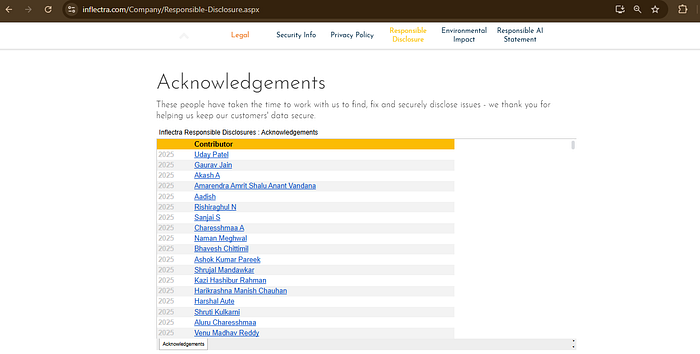"403 Forbidden? Think Again — I Found Something Behind It" …and that discovery earned me a spot in their Hall of Fame 🏅
Hi, I'm Uday — a bug bounty hunter who loves blending recon, automation, and curiosity to hunt down vulnerabilities. In this write-up, I'll walk you through how I discovered an interesting security misconfiguration on Inflectra's infrastructure using FOFA, method-based recon, and a tool called 4-ZERO-3 — and how that led me to a well-earned place in their Hall of Fame.
🎯 The Target: files.Example.com
While exploring domains using FOFA, I came across one that looked promising:
domain="example.com" && header="ASP.NET"This search dork led me to https://files.example.com/secret/, a seemingly innocent directory path that turned out to hold a lot more value than expected.
🔎 Step-by-Step Breakdown of What I Did
Let's dive into the exact methodology I followed.
🛠️ Tools & Techniques I Used
✅ 1. FOFA
A powerful search engine for internet-connected assets. It helped me identify the example.com subdomain running ASP.NET technologies. I narrowed down endpoints that could potentially reveal admin panels, secrets, or misconfigurations.
Why it's useful: You can filter exposed hosts by headers, titles, status codes, and more — perfect for passive recon without sending a single request.
✅ 2. 4-ZERO-3
This is a recon tool that brute-forces forbidden or hidden directories (those that return 403 errors). It looks for misconfigured paths that might return different behavior for different HTTP methods.
Why it's useful in bug bounty: It helps uncover hidden directories that return 403 on GET but might be accessible through other methods like OPTIONS, POST, or TRACE. This aligns directly with OWASP's security misconfigurations — often ignored by developers.
🔍 What I Observed on /secret/
After running 4-ZERO-3 on the example .com files subdomain, I noticed something peculiar:
- GET request to
/secret/gave a 403 Forbidden - OPTIONS request returned a 200 OK with full method list
- And then came the jackpot — TRACE was also enabled
To confirm this, I used a simple curl command:
curl -X OPTIONS https://files.inflectra.com/secret/ -iThis returned headers like:
allow: OPTIONS, TRACE, GET, HEAD, POST
public: OPTIONS, TRACE, GET, HEAD, POSTThis told me the server supports several HTTP methods — including TRACE, which is notorious for enabling Cross-Site Tracing (XST) attacks.
📋 Server Response:
allow: OPTIONS, TRACE, GET, HEAD, POST
public: OPTIONS, TRACE, GET, HEAD, POSTThis told me the server supports several HTTP methods — including TRACE, which is notorious for enabling Cross-Site Tracing (XST) attacks.
🧨 What is Cross-Site Tracing (XST) and Why It's Dangerous?
Cross-Site Tracing (XST) is a type of attack that abuses the TRACE HTTP method — a diagnostic feature intended for debugging. When enabled on a web server, TRACE echoes back the entire HTTP request — including headers like Cookie or Authorization.
This becomes dangerous when combined with Cross-Site Scripting (XSS) or tools like JavaScript running in the browser.
📌 Here's how an attacker might use XST:
Victim visits a malicious page that runs a JavaScript-based XML Http Request using TRACE
If the vulnerable domain allows TRACE, it echoes back sensitive headers (like session cookies)
The attacker grabs this data and hijacks the victim's session
⚠️ Real-World Impact of XST:
- Session Hijacking: Stealing cookies or auth tokens
- Token Leakage: OAuth/JWT tokens exposed via reflected headers
- Recon: Learning what auth headers or proxies are used internally
- Bypassing Security Controls: If combined with misconfigured CORS or XSS

🛡️ Why This Matters in Bug Bounty
Most developers forget about TRACE — it's rarely needed in production, yet often left enabled.
- If a subdomain allows
TRACE, it may leak headers silently - Attackers can use it for internal discovery or to chain it with other bugs (like XSS, CORS, or misconfigured proxies)
🚫 Best Practice: The
TRACEmethod should be disabled in production environments — especially on endpoints handling auth, cookies, or sensitive headers.
🧠 Why This Is a Vulnerability
Let me break it down clearly.
Most developers focus on securing GET and POST, but forget that other HTTP verbs can lead to serious issues:
PUT: lets attackers upload arbitrary filesDELETE: can be used to remove critical filesTRACE: echoes user input, including headers (cookies!), making it a vector for XST
In this case, while GET was blocked, OPTIONS and TRACE responded normally, revealing backend behavior that could be abused by attackers.
According to OWASP, this is classified under Security Misconfiguration, one of the Top 10 risks. It exposes internal workings of the web server and increases attack surface.
📣 What I Reported
- Issue: HTTP Method Misconfiguration
- Path:
/secret/onfiles.inflectra.com - Impact: Revealed internal HTTP method behavior and allowed TRACE method, leading to potential XST or further recon
- Tools used: FOFA, curl, 4-ZERO-3
- Recommended Fixes:
- Disable TRACE globally
- Limit OPTIONS to only whitelisted paths
- Ensure uniform access control across all HTTP methods
🛡️ How Big Was the Bug I Found?
Bug Type: HTTP Method Misconfiguration
The server was unintentionally allowing dangerous HTTP methods like TRACE, and inconsistently blocking GET on sensitive paths like /secret/.
🚨 Why This Is a Big Deal:
These lesser-known HTTP methods can allow an attacker to:
- Upload or run malware (if
PUTorPOSTis also misconfigured) - Delete files or disrupt services (via
DELETE) - Use
TRACEto perform Cross-Site Tracing (XST) attacks and steal cookies or internal headers - Discover internal behaviors that should be hidden from public access
🧠 In Simple Terms:
I basically found a backdoor left unlocked on a server used by real businesses — possibly even enterprise or government clients.
If an attacker had found it before me, they could have used it to steal data, deface the site, or pivot deeper into the infrastructure. But I closed that door first, reported it responsibly, and in return… 💥 I earned my place in their Hall of Fame.
✉️ The Response from Inflectra
I submitted this to their VDP and I got an email asking my name for the HOF:

💥 And the best part?
They added me to their Hall of Fame and logged it as an official security improvement to be rolled out.
🧬 Lessons Learned & Why It Matters
This bug might not be flashy like RCE or SQLi, but it proves how silent misconfigurations can expose backend systems or assist in more complex attacks.
✅ Key Takeaways:
- Hidden dirs + method misconfigs = goldmine
- Tools like 4-ZERO-3 uncover what normal fuzzers miss
- Always test alternate HTTP verbs: OPTIONS, TRACE, PUT, DELETE
- FOFA + light probing = powerful non-intrusive recon
💡 Final Thoughts
This experience reminded me that bug bounty is not just about tools — it's about understanding how systems behave when no one's watching.
Even a seemingly harmless OPTIONS response could be the gateway to something more impactful.
If you're new to bug bounty, start small. Get used to observing subtle behavior, use tools that extend your eyes, and most importantly — report responsibly.
Thanks to Inflectra for their swift acknowledgment and commitment to improving security.
Until next time, — Uday 🐞⚔️ Bug bounty hunter | Curious mind
